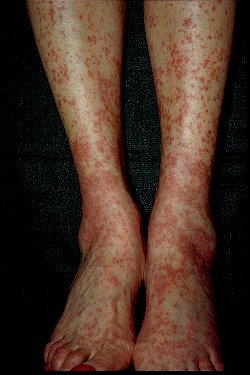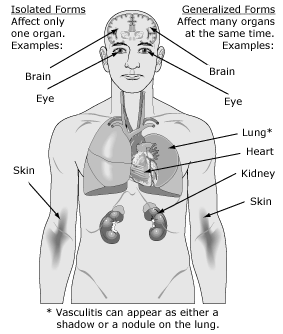In medicine, ‘it is’ is a suffix that means inflammation; for example appendicitis is inflammation of the appendix. Vasculitis is inflammation of the vasculature (blood vessels), including the arteries and/or the veins. Inflammation of the blood vessels is characterized by white blood cells (leukocytes) infiltrating the vessel wallsThis inflammation and the body’s subsequent reactions to it can cause the vessels to become weakened and can impair the integrity of the vessel walls, which in turn can prevent adequate flow of blood through the affected vessels. This can cause ischemia (lack of oxygen) of the organ and body tissues fed by this blood supply, and this is responsible for many of the problems that the different types of vasculitis can cause.
Based on the size of blood vessels involved and the organs affected there are different types of Vasculitis
These patients have nonspecific symptoms like Fever, weight loss, lack of appetite, body aches, joint pains, etc. Each type of vasculitis can also have manifestations based on which organs are involved. Vasculitis patients can develop red spots on the skin and when blood flow decreases, the skin can turn dark resulting in the death of the cells of the affected parts. Similar lesions can affect internal organs like kidney, lungs, heart, etc. This can lead on to renal failure or paralysis.
Image 1

Image 2

The diagnosis of Vasculitis is not very easy. There are criteria proposed by the American College of Rheumatology (ACR) for diagnosis. The diagnosis can only be made by an experienced physician. Presence of an antibody called ANCA helps in diagnosing certain types of Vasculitis.
Despite the difficulty making a definitive diagnosis of vasculitis, early diagnosis is important as these diseases do respond to appropriate treatments. For example, untreated Wegener’s disease has 100% mortality with an average survival of only 5 months. However, treatment of this disease achieves very good results in 80-90% of patients. This illustrates the importance of being persistent to get a definitive diagnosis in patients with possible vasculitis.
During the initial years steroids were the only drugs used in the treatment of these diseases. Currently there are newer drugs like Mycophenolate mofetil, Cyclophosphamide and Rituximab being used to treat these patients effectively. If these diseases are diagnosed early and treated effectively most of the patients get cured.
Causes of autoimmune vasculitis are largely unknown, but thought to be due to a combination of factors, including infection, genetic predisposition, and environmental.